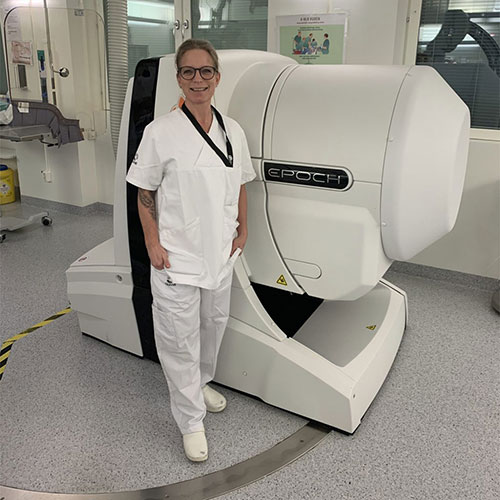
Sara Kristensen, RN
Lund University Hospital
The Stereotaxis catheter is flexible and can reach many areas manual catheters cannot, making it particularly helpful for these patients. It is also gentle, which makes us much more confident in delivering safe treatment.
Sara Kristensen joined Lund University Hospital in 2000, first as a neurosurgery ICU nurse, then in pediatric intensive care, and finally in 2011 with the Electrophysiology team. She describes herself as adventurous and energetic, always wanting to be at the cutting edge where the action is. That spirit motivated Sara to join Lund’s EP team, which is recognized broadly for its leadership in treating rare complex arrhythmias and adopting advanced technology.
“EP is fascinating,” Sara says. “Being ‘inside’ the heart and understanding a patient’s unique arrhythmia is like trying to break out of an escape room – you need to find the clues. Once you find the keys to treat the arrhythmia, the doctor performs the ablation, and you’re out.” Sara enjoys the technical challenge of her job, but is most driven by the connection she has with the patients in her care.
“Patients are very trusting, which is important. They need to rely on me and feel safe,” she says. “Each patient is an individual. Some patients want to know everything about their procedure, and others just close their eyes and want to trust us. By talking to them, we can build a relationship and ease their concerns so they trust us and know we will provide the best care for them.”
When Sara joined the EP team in 2011, it coincided with the hospital’s building of a Robotic EP practice. Stereotaxis robotic technology has become an integral part of the hospital’s EP program, with over 1,000 patients with a broad range of arrhythmias – including ventricular tachycardia, supraventricular tachycardia, atrial fibrillation and atrial flutter – treated to date.
“We treat many patients with grown-up congenital heart disease (GUCH),” also known as adult congenital heart disease. “There is nothing typical in their hearts, and they have often had many heart surgeries. The Stereotaxis catheter is flexible and can reach many areas manual catheters cannot, making it particularly helpful for these patients. It is also gentle, which makes us much more confident in delivering safe treatment.”
“I don’t find the robot intimidating. At first, any new technology can feel imposing, almost the center of attention of the operating room,” Sara recalls. “But soon, it becomes just one of your tools. When you have seen the good things the system can do, you can trust it and rely on it, and your focus is always with the patient.”
As a leader in the EP lab, Sara is responsible for training new lab staff. She begins with education of patient preparation and setup, then moves on to the procedures of the catheter navigation system. “It’s very important when you have that much technology to follow correct procedure workflows,” she says.
When it comes to recommending Stereotaxis, Sara says, “If somebody in my family needed an ablation with robotic technique, I would highly recommend Stereotaxis”

